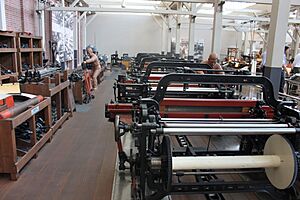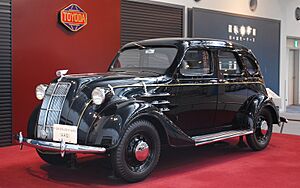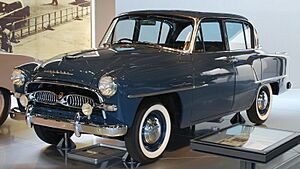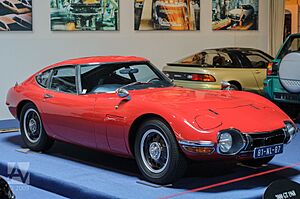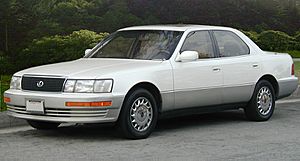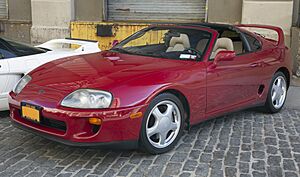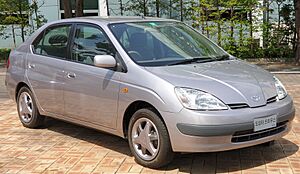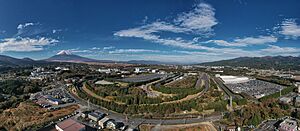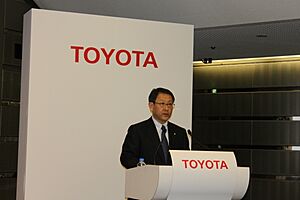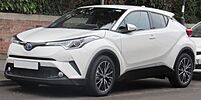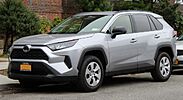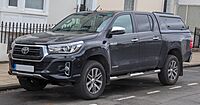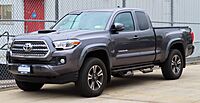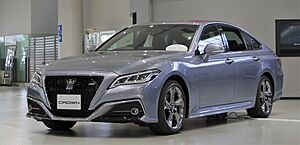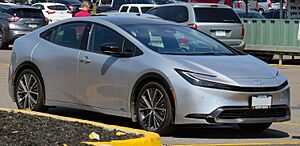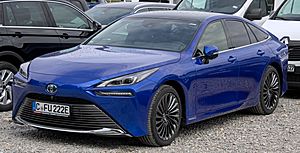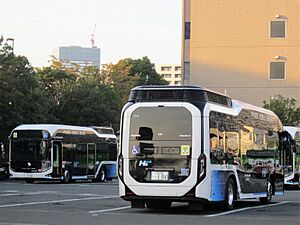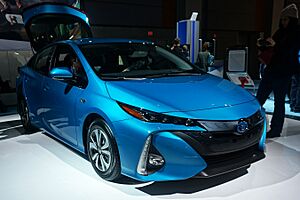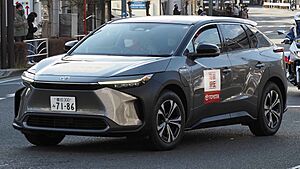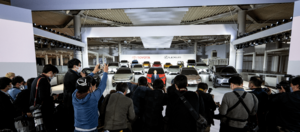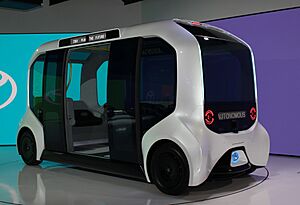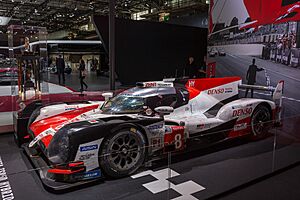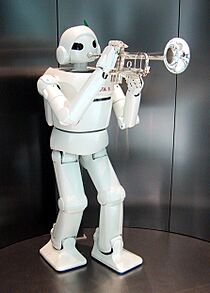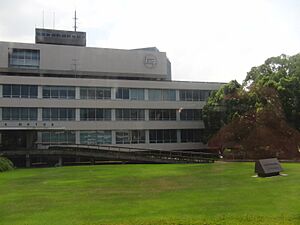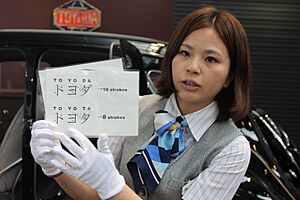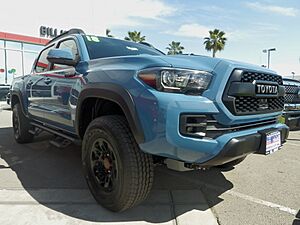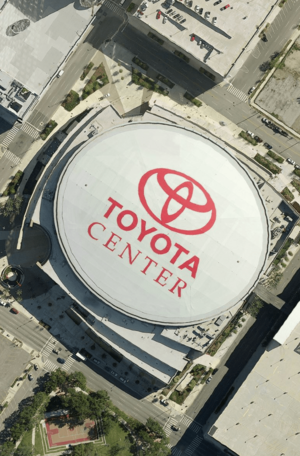Toyota facts for kids
Logo used since October 1989
|
|
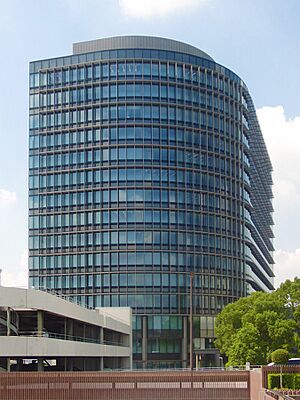
Headquarters in Toyota, Japan
|
|
|
Native name
|
トヨタ自動車株式会社
|
|---|---|
|
Romanized name
|
Toyota Jidōsha kabushikigaisha |
| Public | |
| Traded as | |
| ISIN | ISIN: [https://isin.toolforge.org/?language=en&isin=JP3633400001 JP3633400001] |
| Industry | Automotive |
| Founded | August 28, 1937 |
| Founder | Kiichiro Toyoda |
| Headquarters | 1 Toyota-chō,
Toyota City, Aichi
,
Japan
|
|
Area served
|
Worldwide |
|
Key people
|
|
| Products | Automobiles |
|
Production output
|
|
| Services | Banking, financing, leasing |
| Revenue | |
|
Operating income
|
|
| Total assets | |
| Total equity | |
| Owner | Toyota Group through cross ownership:
|
|
Number of employees
|
|
| Divisions |
|
| Subsidiaries |
|
Toyota Motor Corporation (Japanese: トヨタ自動車株式会社, Hepburn: Toyota Jidōsha kabushikigaisha, IPA: [toꜜjota], English: /tɔɪˈjoʊtə/, commonly known as simply Toyota) is a huge Japanese company that makes cars. Its main office is in Toyota City, Aichi, Japan. Kiichiro Toyoda started the company on August 28, 1937. Toyota is the biggest car maker in the world. It produces about 10 million vehicles every year.
The company began as a part of Toyota Industries, which made machines. That company was started by Sakichi Toyoda, Kiichiro's father. Both companies are now part of the Toyota Group. This group is one of the largest business groups in the world. While still part of Toyota Industries, the company made its first product, the Type A engine, in 1934. Its first passenger car, the Toyota AA, came out in 1936.
After World War II, Toyota learned a lot from American car makers. This helped them create The Toyota Way (a way of managing) and the Toyota Production System (a way to make things efficiently). These ideas helped Toyota become a leader in the car industry.
In the 1960s, Japan's economy grew very fast. Toyota used this chance to sell cars to more and more people. This led to the creation of the Toyota Corolla. It became the best-selling car of all time. Toyota also grew internationally, becoming one of the biggest car makers in the world. By 2012, Toyota was the first car company to make over 10 million vehicles in one year. By September 2023, they had made 300 million vehicles in total!
Toyota was known for making fuel-efficient hybrid electric cars. They started with the original Toyota Prius in 1997. Today, they sell over 40 different hybrid models. More recently, some people have said Toyota was slow to make all-electric cars. Instead, they focused on hydrogen fuel cell cars like the Toyota Mirai.
As of 2024, Toyota Motor Corporation makes cars under four brands: Daihatsu, Hino, Lexus, and Toyota. The company also owns parts of other car companies like Subaru Corporation (20%), Mazda (5.1%), and Suzuki (4.9%). Toyota is listed on major stock exchanges around the world.
Contents
History of Toyota Cars
Early Years: 1920s–1930s
In 1924, Sakichi Toyoda invented an automatic machine called the Toyoda Model G Automatic loom. This machine could stop itself if there was a problem. This idea, called jidoka, later became a key part of how Toyota makes cars. In 1929, the patent for this loom was sold. The money from this sale helped start the car development.
Kiichiro Toyoda, Sakichi's son, led the new Automobile Division. It started on September 1, 1933. They officially announced they would make cars on January 29, 1934. Their first engine, the Toyota Type A engine, was ready in September 1934. Their first car, the A1 sedan, was finished in May 1935. Kiichiro focused on trucks first. The first truck, the G1, was ready in August 1935. It was shown in Tokyo in November and was the first model they sold.
In April 1936, Toyota's first passenger car, the Model AA, was finished. It cost less than cars from Ford or GM. In July, they sent their first four G1 trucks to China. The Japanese government officially recognized Toyota as a car maker in September 1936.
Cars were first sold under the name "Toyoda." This was the family name of the founder. In September 1936, the company held a contest for a new logo. The winning design led to changing the name to "Toyota." This new name was thought to sound better. It also took eight brush strokes to write in Japanese, which is a lucky number. The new name was trademarked, and the company became Toyota Motor Company Ltd. on August 28, 1937.
During World War II, Toyota mostly made trucks for the Japanese Army.
Rebuilding After War: 1940s
Japan was badly damaged in World War II. Toyota's factories were also hit. After the war, the U.S. forces in Japan stopped passenger car production. But car makers like Toyota could build trucks to help rebuild the country. The U.S. military also hired Toyota to fix their vehicles.
By 1949, Japanese car makers could make passenger cars again. However, the economy was tough, and many truck owners couldn't pay their loans. The Bank of Japan helped Toyota, but asked the company to make big changes.
Growing Stronger: 1950s
In the early 1950s, Toyota was smaller and faced money problems. But then the Korean War started. The U.S. Army ordered 1,000 trucks from Toyota. This helped the company's business a lot. In 1950, Toyota leaders, including Eiji Toyoda, visited the United States. They learned from Ford Motor Company and other factories. This knowledge, along with what they learned from making looms, led to The Toyota Way and the Toyota Production System. These ideas helped Toyota become a leader in manufacturing.
Toyota started making its first full passenger car, the Toyopet Crown, in 1952. Before this, Toyota had others design and build car bodies. The Crown project was a big test for Toyota. They needed to build comfortable cars that could handle Japan's muddy roads. The first test cars were ready in June 1953. The Crown went on sale in August 1955 and was well-liked.
After the Crown, Toyota started selling cars in other countries. They entered Saudi Arabia in 1955 with Land Cruisers. In 1958, Toyota opened its first factory outside Japan, in Brazil.
Toyota entered the United States market in 1958 with the Toyopet Crown. But it didn't do well. Buyers found it too expensive and not powerful enough for American roads. So, Toyota stopped selling the Crown in the U.S. in the early 1960s. Instead, they focused on the Land Cruiser and the Tiara.
Global Expansion: 1960s–1970s
In the 1960s, Japan's economy was booming. More people could afford cars. The Japanese government also improved roads. Toyota and other car makers started offering affordable cars like the Toyota Corolla. It became the world's best-selling car ever.
Toyota also did well in the United States with the Toyota Corona compact car in 1965. This car was changed for the American market with a stronger engine. Toyota's sales in the U.S. grew a lot. By 1967, it was the third-best-selling imported car brand. In 1972, Toyota started making truck beds in the U.S. to avoid extra taxes on imported trucks. This was successful, and Toyota bought the company two years later.
In the 1970s, the "energy crisis" made people want smaller, more fuel-efficient cars. Toyota was good at making these cars. This led to more sales for Toyota. To make Japan's car industry stronger, Toyota bought parts of other Japanese car makers. This included Hino Motors, which makes trucks and buses, and Daihatsu, which makes small cars.
New Markets and Brands: 1980s
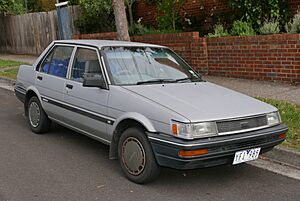
After its success in the 1970s, Toyota started investing more in North America in the 1980s. In 1981, Japan agreed to limit the number of cars it sent to the U.S. each year. This led Toyota to build factories in North America.
In 1981, Eiji Toyoda became chairman, and Shoichiro Toyoda, the founder's son, became president. Shoichiro worked to combine Toyota's sales and production teams. In 1982, they became one company: Toyota Motor Corporation.
In 1984, Toyota partnered with General Motors (GM) to create a car factory called NUMMI in California. GM wanted to learn about Toyota's quality and production system. Toyota wanted a factory in North America to avoid import taxes and learn about the American labor market. The first Toyota car made in America, a white Corolla, came off the line at NUMMI on October 7, 1986.
Before the 1980s ended, Toyota launched Lexus. This was a new brand for selling luxury cars in other countries. Toyota had been secretly developing Lexus since 1983. The LS 400 luxury sedan came out in 1989. It sold very well and helped make Lexus a successful brand.
Innovation and Growth: 1990s
In the 1990s, Toyota started making more than just compact cars. They added larger and more luxurious vehicles. These included big pickup trucks like the T100 (and later the Tundra) and many SUVs. They also released new versions of their sports cars, like the MR2, Celica, and Supra.
In December 1997, Toyota introduced the first-generation Toyota Prius. This was the first mass-produced gasoline-electric hybrid car. For the first two years, it was only sold in Japan.
Toyota also grew its presence in Europe and the United Kingdom. They set up offices and factories there. In 1998, Toyota became the main owner of Daihatsu by increasing its share to 51.2%. On September 29, 1999, Toyota listed its shares on the New York and London Stock Exchanges.
New Millennium Challenges: 2000s
In August 2000, the Prius started being exported to other countries. In 2001, Toyota bought Hino Motors, a truck and bus maker. In 2002, Toyota started competing in Formula One racing. They also created a new brand for young buyers in North America called Scion in 2003.
In 2007, Toyota released an updated version of its large truck, the Tundra. It was made in American factories. The Toyota Camry was named "Car of the Year" for 2007. Toyota was the number one car seller in the world for the first part of 2008.
Toyota was affected by the 2008 financial crisis. In December 2008, they had their first yearly loss in 70 years. They closed their Japanese factories for 11 days to reduce unsold cars.
Between 2009 and 2011, Toyota had to fix millions of vehicles. There were reports that some cars sped up by themselves. Toyota worked to fix problems with floor mats and accelerator pedals. The company took steps to address these issues and improve safety.
During this time, Akio Toyoda, the grandson of the company's founder, became President of Toyota on June 23, 2009. He had worked at Toyota since 1984 in different roles. His promotion brought a Toyoda family member back to the top leadership role.
Adapting to Change: 2010s
In 2011, natural disasters in Japan, like the 2011 Tōhoku earthquake and tsunami, affected Toyota's production. Flooding in Thailand also caused problems. Toyota lost production of many cars due to these events.
On February 10, 2014, Toyota announced it would stop making vehicles in Australia by the end of 2017. This was because it was too expensive to make cars there. Other car companies like Ford and GM also stopped making cars in Australia.
In August 2014, Toyota lowered its spare-parts prices in China. This was in response to an investigation into high prices for car parts.
In November 2015, Toyota announced it would invest $1 billion over five years in artificial intelligence and robotics research. In 2016, Toyota invested in the ride-sharing company Uber. In August 2016, Toyota bought all remaining parts of Daihatsu, making it a fully owned company.
In October 2019, Toyota supported a proposal that would change fuel efficiency standards in the U.S. This caused some concern about Toyota's image as a "green" brand.
Looking to the Future: 2020s
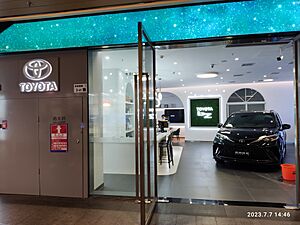
By 2020, Toyota was again the largest car maker in the world, even with a drop in sales due to the COVID-19 pandemic. This includes cars from its companies Daihatsu and Hino Motors.
In April 2020, Toyota and BYD started a new company together called BYD Toyota EV Technology Co., Ltd. Their goal is to make new electric cars that customers will love.
In March 2021, Toyota, Hino, and Isuzu formed a partnership. They created a new company called Commercial Japan Partnership Technologies Corporation. This company aims to develop fuel cell and electric light trucks.
In April 2021, Toyota bought Lyft's self-driving technology unit for $550 million. They merged it with their new automation division, Woven Planet Holdings.
In December 2021, Toyota announced big plans for electric vehicles. They said they would invest 8 trillion JPY (about $70 billion) in electric vehicles by 2030. They also plan to launch 30 new electric car models worldwide by then. Their goal is to sell 3.5 million electric vehicles in 2030.
In June 2022, Toyota recalled 2,700 of its first mass-produced all-electric vehicles, the bZ4X. This was due to concerns that their wheels could loosen. Toyota quickly addressed the issue.
In August 2022, Toyota promised up to $5.6 billion for electric vehicle battery production. They also increased investment in their plant in North Carolina. In 2022, Toyota remained the world's best-selling car maker for the third year in a row.
In January 2023, Toyota CEO Akio Toyoda stepped down. Koji Sato, who used to run Lexus, became the new CEO and President. In 2023, Toyota also gave its employees the largest wage increase in 20 years.
In July 2024, Toyota announced plans to build an electric car battery plant in Fukuoka, Japan. These batteries will be sent to other parts of Asia. In October 2024, Toyota announced it would return to Formula One racing after 15 years, partnering with the Haas team. In November 2024, Toyota and Joby Aviation completed a test flight of an electric air taxi in Japan. Toyota had invested a lot in Joby for this project.
In June 2025, Toyota announced it would raise prices for some vehicles sold in the US. This was due to new taxes on imported car parts.
Toyota's Car Lineup
| Best-selling Toyota and Lexus nameplates/series globally, FY2023 |
||
|---|---|---|
| Rank in Toyota |
Model | Sales (thousands of units) |
| 1 | Toyota Corolla | 1,538 |
| 2 | Toyota Yaris | 900 |
| 3 | Toyota RAV4 | 847 |
| 4 | Toyota Hilux | 648 |
| 5 | Toyota Camry | 642 |
| 6 | Toyota Highlander | 379 |
| 7 | Toyota Tacoma | 260 |
| 8 | Toyota Levin | 195 |
| 9 | Toyota Fortuner | 177 |
| 10 | Toyota Avanza | 175 |
Toyota makes about 70 different models under its main brand. These include sedans, vans, trucks, hybrids, and SUVs. Popular sedans range from the small Toyota Yaris to the mid-size Toyota Camry. Minivans include the Toyota Sienna. Some small cars were also sold under the Scion brand.
SUVs and Crossovers
Toyota's lineup of SUVs and crossovers has grown a lot. This is because more people want these types of vehicles. Toyota crossovers include the small Yaris Cross and C-HR. Mid-size ones are the RAV4 and Highlander. Toyota SUVs range from the mid-size Fortuner to the large Land Cruiser.
Pickup Trucks
Toyota started making pickup trucks in 1947 with the SB. In 1968, they introduced the compact Hilux. The Hilux became known for being very strong and reliable. Toyota still makes them today in different sizes and with different engines.
In North America, the Hilux was very popular. This led Toyota to launch the Tacoma in 1995. The Tacoma was based on the Hilux but designed for North American drivers. It became the best-selling compact pickup truck there.
Toyota also decided to make larger pickup trucks for the U.S. market. They introduced the T100 in 1993. In 1999, Toyota replaced the T100 with the bigger Tundra. The Tundra was built in the U.S. with a V8 engine, similar to other American full-size trucks.
Luxury Vehicles
In Japan, Toyota has two main luxury cars: the Crown sedan and the Century limousine.
In the 1980s, Toyota wanted to sell luxury cars worldwide. But their Japanese luxury models weren't well-known globally. So, Toyota created Lexus, a new brand for luxury vehicles outside Japan. They developed Lexus secretly for many years. The Lexus LS sedan came out in 1989 and was very successful. Lexus now offers many types of luxury cars, including sedans, coupes, and SUVs.
The Lexus brand was introduced in Japan in 2005. Before that, Lexus cars sold internationally were called Toyota models in Japan.
Buses
The Toyota Coaster is a minibus that started in 1969. It can seat 17 passengers. The Coaster is used in many countries for public transportation. The Toyota HiAce is also sometimes used as a minibus.
Toyota's Technology
Hybrid Electric Vehicles
Toyota is the world leader in selling hybrid electric cars. They were the first to sell these cars to many people, starting with the Prius in 1997. Toyota's hybrid technology is called Hybrid Synergy Drive. It is used in many Toyota and Lexus vehicles.
As of January 2020, Toyota sells 44 different Toyota and Lexus hybrid car models in over 90 countries. The company has sold over 15 million hybrid vehicles since 1997. The Prius family of cars is the world's top-selling hybrid car series.
Hydrogen Fuel-Cell Vehicles
In 2002, Toyota started testing the Toyota FCHV, a hybrid hydrogen fuel cell car. It was based on the Toyota Highlander SUV. Toyota also built a fuel-cell bus.
Toyota's first hydrogen fuel-cell car sold to the public was the Toyota Mirai (which means "future" in Japanese). It was shown in November 2014. Production of the Mirai increased from 700 cars in 2015 to 3,000 in 2017. Sales in Japan began in December 2014. It started selling in the U.S. in August 2015, mainly in California.
In 2015, Toyota made 5,600 of its patents for hydrogen fuel-cell technology free to use until 2020. They hoped this would help develop the technology worldwide. Since the mid-2010s, Toyota has also focused on building hydrogen-powered trucks.
Plug-in Hybrid Vehicles
Toyota showed the Prius Plug-In Hybrid Concept in late 2009. Then, they started a program to test 600 of these cars. These cars were given to companies and governments to track their performance. The car was based on the third-generation Toyota Prius. It had extra batteries that allowed it to run mostly on electricity for a certain distance.
The production version of the Prius Plug-in Hybrid was shown in September 2011. It could go up to 62 mph (100 km/h) on electric power alone. Toyota made about 75,400 of these cars between 2012 and 2016.
The second-generation Prius Plug-in (called Prius Prime in the U.S.) came out in early 2016. This model was designed with the fourth-generation Prius. This allowed Toyota to increase its electric range to 25 miles (40 km) and a top speed of 84 mph (135 km/h) without needing the gasoline engine.
A second plug-in hybrid model, the Toyota RAV4 PHV (RAV4 Prime in the U.S.), was shown in December 2019. It can go about 42 miles (68 km) on electric power. Sales started in mid-2020.
Battery Electric Vehicles
Toyota has been criticized for being slow to add battery electric vehicles to its lineup. They have focused more on hybrid and hydrogen fuel cell cars.
As of 2023, only a small number of the vehicles Toyota sells are battery electric. The company plans to increase its electric vehicle sales to 3.5 million per year by 2030. However, Toyota believes other technologies, like hybrids and hydrogen fuel cells, will still be important.
Toyota made the first Toyota RAV4 EV (Electric Vehicle) in the late 1990s. This was because California required car makers to offer a zero-emissions vehicle. About 1,484 were leased or sold in California from 1997 to 2003.
A second version of the RAV4 EV was made in 2010 with Tesla. It used Tesla's battery and parts. Only about 3,000 of these were made before it was stopped in 2014.
In late 2012, Toyota said it would step back from fully electric vehicles for a while. They felt electric cars at the time didn't meet needs for distance, cost, or charging time.
However, Toyota's view on electric cars started to change around 2016. They announced plans to introduce "more than 10" battery-electric vehicles worldwide by the early 2020s.
In April 2019, Toyota launched the C-HR EV, its first mass-produced pure electric car in China. In December 2020, Toyota introduced the C+pod, a small 2-seater electric car.
In April 2021, Toyota showed the bZ4X. This electric SUV is the first car built on a special electric platform called e-TNGA. It is the first model in the bZ ("beyond Zero") of electric vehicles. Toyota plans to launch seven "bZ" models out of 15 electric models by 2025.
In December 2021, Toyota announced plans for 30 battery-electric models by 2030. They aim to sell 3.5 million electric vehicles per year by that date. Their luxury brand, Lexus, will be 100% electric by 2030 in North America, Europe, and China. The company announced investments of $70 billion in electric cars.
Toyota has been working with Panasonic to develop solid-state batteries. This technology could make electric vehicles 30% more efficient and reduce battery costs.
Autonomous Vehicles
Toyota is also working on smart car technology. They showed their first self-driving test vehicle in 2017. They are developing their own self-driving systems called "Chauffeur" (for full self-driving) and "Guardian" (a driver assist system).
By 2018, Toyota had set up large research centers. They invested billions to study autonomous vehicles in California and Tokyo. Toyota has also partnered with and bought companies that develop self-driving technology.
In December 2020, Toyota showed the 20-passenger "e-Palette" shared autonomous vehicle. It was used at the 2020 Summer Olympics in Tokyo. Toyota plans to make this vehicle available for businesses before 2025.
Since February 2021, Toyota has been building the "Woven City" in Japan. It's a "high-tech city" where they will test autonomous vehicles for deliveries, transport, and mobile shops. People living there will be part of this experiment.
Motorsports
Toyota has been involved in many global motorsports series. They provide vehicles, engines, and other parts for racing under both the Toyota and Lexus brands.
Toyota Gazoo Racing (GR) is Toyota's performance brand used in major motorsports. Toyota Gazoo Racing Europe competes in the FIA World Endurance Championship. Toyota Gazoo Racing WRT participates in the FIA World Rally Championship. Toyota Gazoo Racing South Africa competes in the Dakar Rally. The Toyota Racing team competed in Formula One from 2002 to 2009. Toyota won the top class of the 24 Hours of Le Mans five times in a row from 2018 to 2022.
Toyota Racing Development USA (TRD USA) handles Toyota's participation in major motorsports in the United States. This includes NASCAR and NHRA.
Toyota also makes engines and parts for other Japanese motorsports like Super Formula and Super GT.
Other Activities
Aerospace
Toyota owns a small part of Mitsubishi Aircraft Corporation. This company makes the Mitsubishi Regional Jet. Toyota has also looked into making planes for general use.
Pleasure Boats
In 1997, Toyota created "Toyota Marine." They build private motorboats, which are currently sold only in Japan. These luxury boats are called the "Toyota Ponam" series. In 2017, a boat was also released under the Lexus brand name.
Robotics
In 2004, Toyota showed its trumpet-playing robot. Toyota has been developing robots for elderly care, manufacturing, and entertainment. For example, they have a Brain Machine Interface for wheelchairs. It lets a person control an electric wheelchair with their mind. Toyota also helped develop Kirobo, a 'robotic astronaut'.
In 2017, the company introduced T-HR3, a human-like robot that can be controlled remotely. The robot can copy a person's movements.
Sewing Machines
Aisin, another company in the Toyota Group, uses the Toyota logo for its home sewing machines. Aisin was founded by Kiichiro Toyoda after he started Toyota Motor Corporation. He liked the first sewing machine so much that he decided to use the Toyota brand name for it.
Environmental Efforts
Toyota aims to be carbon neutral by 2050. This means they want to have no net carbon emissions. They also want to reduce their total carbon emissions by 90% by 2050 compared to 2010 levels.
The company has invested a lot in solar energy. They plan to put solar panels on all their dealerships worldwide by 2050. Toyota also works with renewable energy companies to promote wind and solar power.
Toyota has a program called "Global Environmental Challenge 2050." This plan aims to reduce the environmental impact of Toyota's operations. It includes goals like reducing carbon emissions, using less water, and recycling more materials. Toyota also tries to have zero waste at its factories.
Company Information
Toyota's main office is in Toyota City, Japan. This city was named Koromo until 1951, when it changed its name to match the car company. Toyota City is in the Aichi Prefecture of Japan. The main headquarters building is a four-story building.
Around the headquarters are the Toyota Technical Center and the Honsha plant, which started in 1938. Toyota and its related companies have 17 factories in Aichi Prefecture and 32 plants in Japan. Toyota also has offices in Tokyo and Nagoya.
Financial Performance
| Region | Share |
|---|---|
| Japan | 36.4% |
| North America | 31.1% |
| Asia | 15.1% |
| Europe | 9.8% |
| Other | 7.6% |
As of 2024, Toyota was the world's largest car company. Its revenue was over US$400 billion. For the fiscal year 2024, Toyota reported earnings of ¥4.9 trillion. Its yearly revenue was ¥45.1 trillion, which was a 21.4% increase from the year before. This was mainly because Toyota sells most of its cars outside Japan.
Global Presence
| Top 10 Toyota and Lexus vehicle production by country, 2024 |
||
|---|---|---|
| Rank in Toyota |
Location | Vehicle production |
| 1 | 3,128,351 | |
| 2 | 1,508,238 | |
| 3 | 1,270,206 | |
| 4 | 536,158 | |
| 5 | 533,587 | |
| 6 | 388,582 | |
| 7 | 279,602 | |
| 8 | 260,346 | |
| 9 | 245,009 | |
| 10 | 225,236 | |
Toyota has factories in many parts of the world outside Japan. They assemble vehicles in countries like Argentina, Belgium, Brazil, Canada, and the United States. They also have joint factories or partnerships in China, India, and other places.
North America Operations
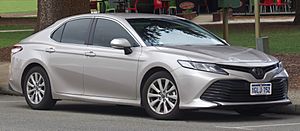
Toyota Motor North America's main office is in Plano, Texas. It manages all of Toyota's business in Canada, Mexico, and the United States. Toyota started its operations in North America on October 31, 1957.
Toyota has a big presence in the United States with six major assembly plants. These are in Alabama, Kentucky, Indiana, Texas, West Virginia, and Mississippi. In 2018, Toyota and Mazda announced a joint factory in Alabama that started making vehicles in 2021.
Toyota also makes larger trucks in the U.S., like the new Tundra. They also promote hybrid electric cars like the Prius and Camry Hybrid.
Toyota Canada Inc. handles sales and distribution in Canada. Toyota Motor Manufacturing Canada has three assembly plants in Ontario.
Europe and Western Asia Operations
Toyota Motor Europe's main office is in Brussels, Belgium. It manages all of Toyota's business in Europe and western Asia. Toyota started its operations in Europe in 1963. Toyota has nine production factories in Europe, including in England, France, and Turkey. Toyota also has a joint factory with Citroën and Peugeot in France.
Australia Operations
In 1963, Australia was one of the first countries to assemble Toyotas outside Japan. However, in February 2014, Toyota announced it would stop making cars in Australia. The factory closed on October 3, 2017. It had made over 3.4 million vehicles. Other car companies like Ford and GM's Holden also stopped making cars in Australia.
Toyota's Company Strategy
The Toyota Way
The Toyota Way is a set of ideas and actions that guide how the company manages and produces things. It's also linked to the Toyota Production System.
Toyota has been developing its company ideas since 1948. As the company grew globally, leaders officially wrote down The Toyota Way in 2001. Toyota sums it up with two main ideas: constant improvement and respect for people.
Under "constant improvement" are three principles:
- Challenge: Have a long-term vision.
- Kaizen: Always look for ways to improve things.
- Genchi Genbutsu: "Go and see" the actual process to make good decisions.
Under "respect for people" are two principles:
- Respect: Treat everyone with respect.
- Teamwork: Work together to achieve goals.
In 2004, a professor named Dr. Jeffrey Liker wrote a book called The Toyota Way. He said it's "a system designed to provide the tools for people to continually improve their work."
Toyota Production System
The Toyota Way also shaped how Toyota makes cars. They were pioneers of what's called lean manufacturing. Toyota defines its production system with two main ideas:
- Just-in-time: Make only what is needed, only when it is needed, and only the right amount.
- Jidoka: Automation with a human touch, meaning machines stop when a problem happens.
The Toyota Production System has helped many companies. Toyota started teaching this system to its suppliers in the 1990s. They also offer training sessions to other companies and even non-profit groups to help them work more efficiently.
Logo and Branding
In 1936, Toyota held a contest for a new logo. The winning design led to changing the company name from "Toyoda" to "Toyota." The new name was thought to sound better. It also took eight brush strokes to write in Japanese, which is a lucky number.
As the company grew internationally, they added the English word "TOYOTA" to their logo.
Toyota introduced a worldwide logo in October 1989 to celebrate its 50th year. This logo has three ovals that form the letter "T" for Toyota. Toyota says the two inner ovals show the good relationship and trust between the customer and the company. The larger oval around them shows Toyota's global growth and future potential. This new logo started appearing on cars and ads in 1990.
In Japan, the Toyota logo is often only on the back of the car. The front grille usually has a special badge for that car model. For example, Corollas have a stylized "C" badge.
Toyota still uses its original Japanese character logo as its company symbol in Japan. Some special edition cars also use the "TOYOTA" wordmark on the grille as a nod to the company's history.
Sports Sponsorships
Toyota sponsors many sports teams and has bought the naming rights for several sports venues and competitions. These include:
- Toyota Alvark Tokyo, a basketball team.
- Toyota Center, a sports arena in Houston, Texas.
- Toyota Field, a stadium in San Antonio, Texas.
- Toyota Stadium, a stadium in Frisco, Texas.
As of 2017, Toyota is an official sponsor of Cricket Australia and the Australian Football League.
In March 2015, Toyota became a sponsor for the Olympic Games and Paralympic Games. They provided vehicles and communication between vehicles starting in 2018. In May 2024, Toyota announced it would not continue its contract after the 2024 games in Paris. However, Toyota hopes to keep its contract with the International Paralympic Committee.
See also
 In Spanish: Toyota para niños
In Spanish: Toyota para niños
- Automotive industry in Japan
- List of Toyota engines
- List of Toyota manufacturing facilities
- List of Toyota transmissions
- List of Toyota vehicles
- Nagoya Grampus, a football club sponsored by Toyota.
- Toyota model codes
- Toyota Verblitz, Toyota's rugby team.
- Toyota War, a conflict where Toyota pickup trucks were used a lot.


